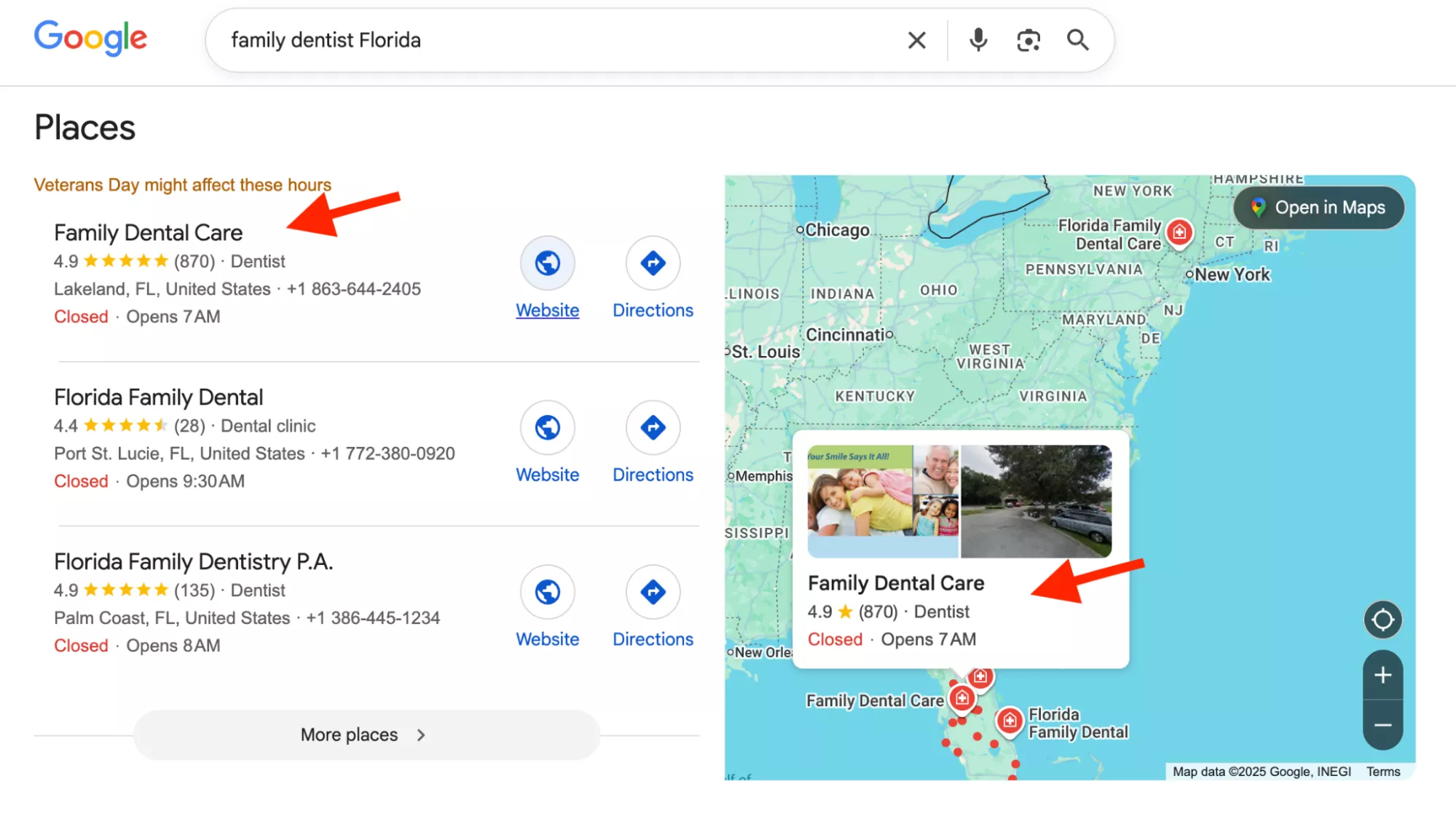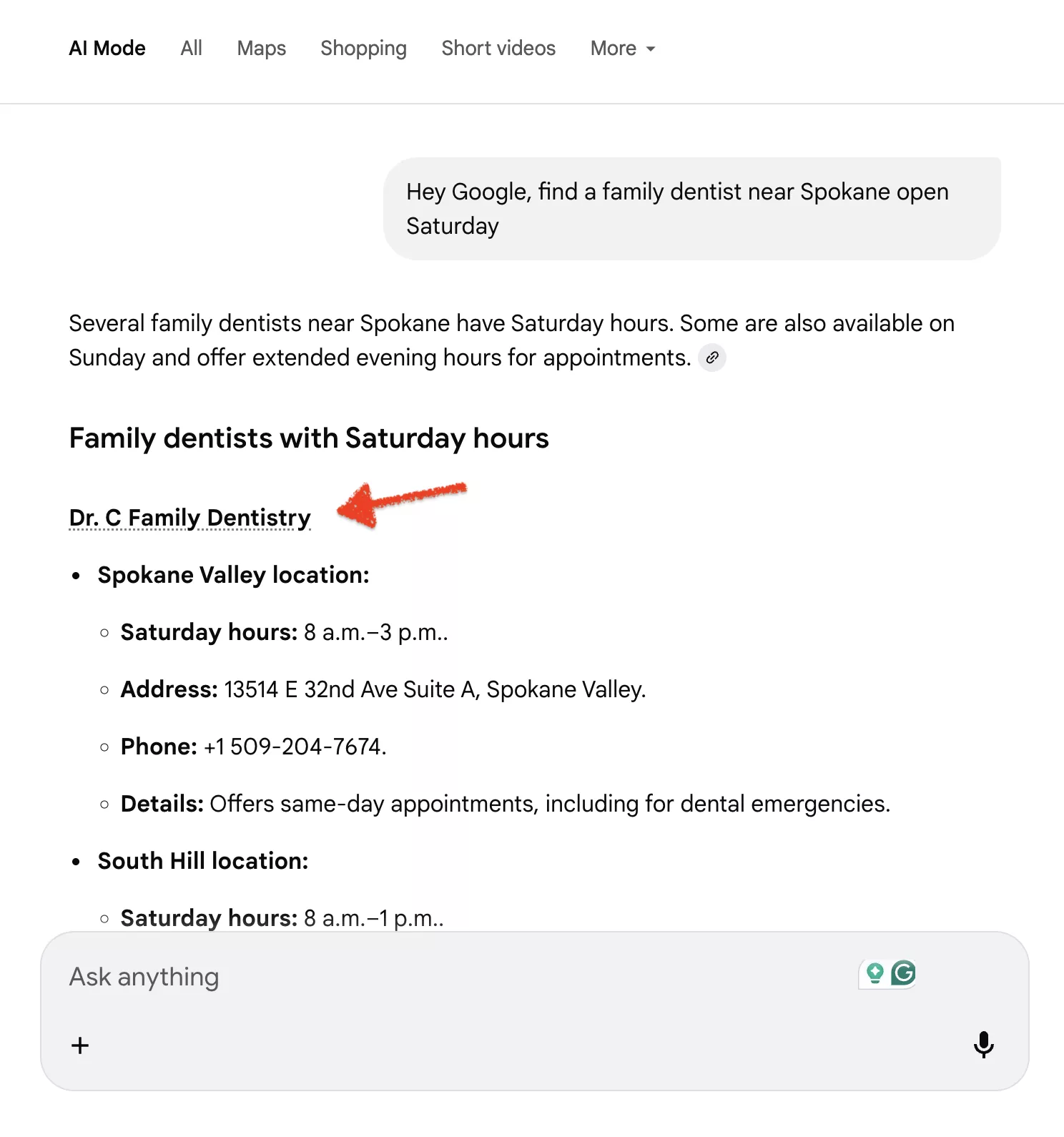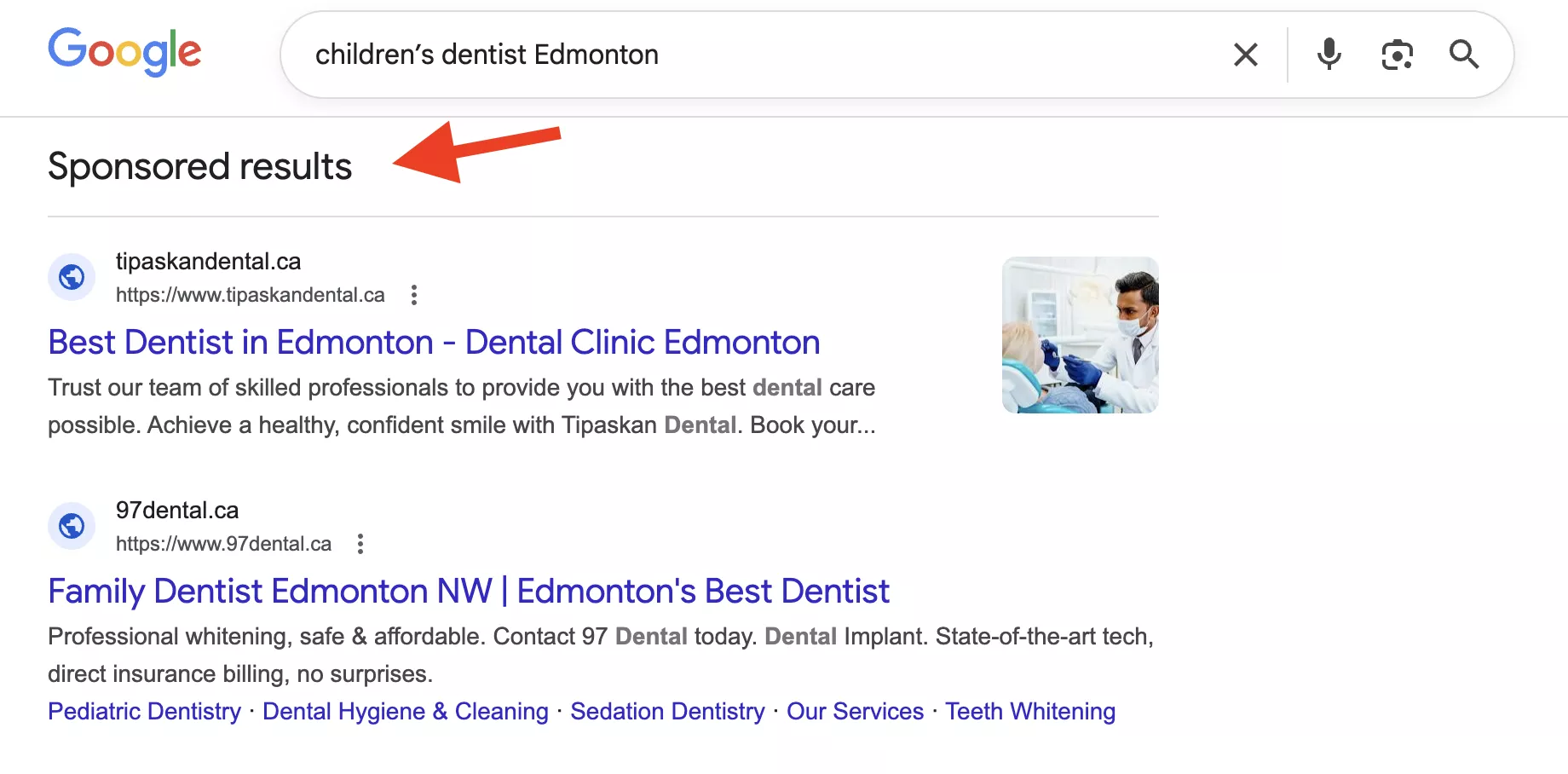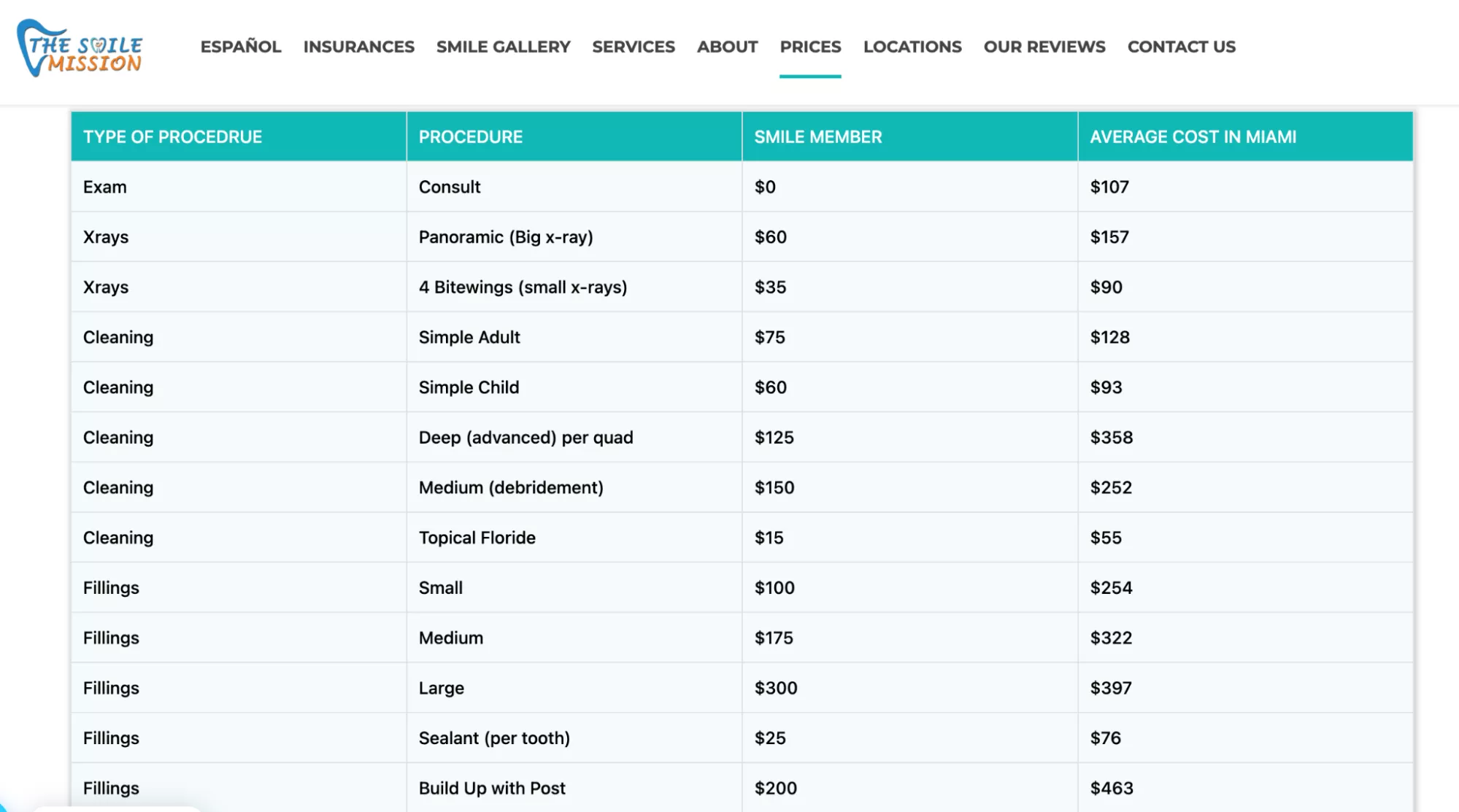AI-powered search assistants, local SEO, voice search, paid ads, social media, reputation management, loyalty programs — there’s no shortage of smart ways to promote a dental clinic. The future is here! Word-of-mouth and casual walk-ins are great, but they need a little digital marketing for dentists.
How to attract new patients and keep current ones coming back? How to market your dental office to keep your calendar full? Let’s find out.
What is Dental Marketing?
Dental marketing is the process of promoting a dental clinic’s services through local SEO, Google Ads, social media, email, SMS reminders, reputation management, etc. More than 70% of consumers research online and read reviews when looking for a new dentist, so you need to meet them there.
Why invest in marketing for a dental clinic? Because it works — and brings real results for your clinic:
-
New patients are arriving. Try launching a simple Facebook ad for teeth whitening services in your area. If done correctly, people who have never heard of your dental business will become first-time visitors.
-
Patients are coming back. Sometimes, a few friendly email reminders are enough to help patients feel valued. And when people feel so, they stay and book again.
-
Revenue is growing. You can promote free Invisalign consultations or a bundled cleaning + whitening offer at any time. All of these little tricks fill your schedule and encourage higher-value treatments.
-
Reputation becomes strong. Google reviews make people trust you even before they walk through your door. 72% of patients are happy to travel a bit farther just to see a dentist with top ratings!
Netpeak is a full-cycle digital marketing agency that specializes in dental digital marketing. We know how to promote a dental clinic to keep your business up to date. Contact us, and we'll help!
What Are the Dental Marketing Trends in 2025?
The main dental marketing trends in 2025 are hyper-local optimisation, AI chatbots, personalised marketing, and subscription models. You should keep an eye on them to promote your dental practice.
Trend 1: Hyper‑Local Optimisation
-
Practices are focusing on hyper‑local SEO (e.g., “dentist Brooklyn”, “dental clinic Long Island”). The goal is to capture patients within a 5 km radius.
-
Many patients use voice search for queries like “dentist open now near me” via mobile or an assistant.
Trend 2: AI and Automation
-
Chatbots and virtual receptionists aren’t sci‑fi anymore — they answer FAQs, book appointments, and send gentle reminders.
Trend 3: Personalised Marketing & Subscription Models
-
Clinics started skipping the generic messages. They send personal reminders like, “It’s been 9 months since your last cleaning — let’s get you sparkling again!”
-
An increasing number of dental businesses are offering subscription and membership plans with fixed monthly rates. These plans are ideal for people without health insurance.
“The funny thing about dental marketing trends is that it’s all about common sense. Rank where you provide your services (you don’t need to be the #1 dentist on Google to get bookings in Atlanta), replace 9-5 receptionists with 24/7 AI, and build your communication like you actually care about your patients. Isn’t it crazy?
What will make a difference is how you treat your reputation and these new good-for-everything GPTs.
Sam Altman’s focus on building a human-like personal assistant (I, Robot movie hits different in 2026, doesn’t it?) rather than another search tool is obvious — and, as GPTs get more information about you, they will do everything they can to ensure a hyperpersonalized experience.
They will know that you don’t like to wake up early, don’t trust reviews without photos, and prefer not to go downtown for dental procedures. Guess what? You will need to cover all of these scenarios for GPT to recommend you.”
— Leonid Kovalenko, Head of Marketing at Netpeak US
What Are the Best Digital Channels for a Dental Business?
Your dental marketing toolbox is full of SEO, PPC, SMM, SERM, and AI-assisted search optimization. Don’t be scared of all these abbreviations. Let’s learn what they mean and how they can actually help market a dental clinic.
SEO (Search Engine Optimization)
Dental SEO helps to make your website Google’s favorite — so when patients search for “child dental clinic Bronx” or “family dentist Florida,” they find you first.
Look, Family Dental Care nailed SEO and finished at the top of the search results.
How they did so:
-
Their Google Business Profile is up-to-date, has glowing reviews, and a consistent Name, Address, and Phone.
-
They worked on backlinks & local mentions from community directories, press articles, and local groups.
-
They build service pages for each specialty and sprinkle local keywords.
AI‑assisted Search Optimisation
People are talking to Google (and Siri, Alexa…) more than typing. You should use it to promote a dental office.
For example, Dr. C Family Dentistry has a good relationship with AI. So they are the first name people see when they say, “Hey Google, find a family dentist near Spokane open Saturday.”
What did they do to be there?
-
First of all, their Google Business Profile is spot-on with glowing reviews.
-
Their blog gives answers to human questions: “Quick Ways to Soothe a Flare” or “What Is Enamel and Why Should Parents Care?”
-
They use long-tail and question-style keywords in their articles.
PPC (Pay-Per-Click)
Healthcare PPC marketing is when you pay only when someone clicks your ad. It’s expensive, but it works great, especially for high‑intent searchers (e.g., “dentist emergency Shelby”, “children’s dentist Edmonton,” etc).
What PPC platforms work best for dental clinics this year?
-
Google Ads — for capturing people who are searching for a dentist.
-
Meta Ads — for promotions and special offers.
-
Microsoft Bing Ads — potentially has lower CPC, so can be worthwhile in smaller markets.
-
TikTok Ads — for those addicted to short videos, which is almost everyone.
What is the average CPC for Google Search Ads (dentistry) in 2025?
Cost Per Click (CPC) is the amount you pay every time someone clicks on your online ad — for example, a Google Ads or Facebook Ads campaign.
|
Source |
CPC for dentists |
|
WordStream benchmarks |
~$7.85 |
|
Mega Digital benchmarks |
~$6.69 |
|
DentalScapes guides |
|
SMM (Social Media Marketing)
You can choose which placement will be the dental social media — Instagram, Facebook, or TikTok. Either way, creating content would be worth it. Since people are always online, you need to be there too.
A great example is Sunrise Pediatric Smiles Clinic. They share fun posts and reels with happy children who aren’t scared of dentists at all.
SERM (Search Engine Reputation Management)
SERM is the guardian of your online reputation. You need to keep an eye on your clinic's reviews on Google and social media, and respond fast. Sure, haters gonna hate, but you need to be civil with them and promise improvements.
It shows patients that you care, and trust is everything for a local dental business.
A good example is Children First Dental in Edmonton. They thank patients for positive reviews and handle negative ones well. They sound like great guys! That should be your goal too!
“It’s not 2015 anymore, and 5 stars on Google Reviews are not enough. Every location must be supported by reviews that provide a look into a specific patient’s life and the problem you solved. You should have a steady flow of reviews, and negativity must be addressed better than “Dear reader, we reached out to the person who left us a negative review, and it’s all ok now. Not to forget about your presence on booking and review platforms, social media, maps, and more. A lot of work here.”
— Leonid Kovalenko, Head of Marketing at Netpeak US
Specifically Dental Digital Marketing Strategies
Dental marketing is special — you work with patients. You can’t stop just with ads and social media posts. We at Netpeak know how to market your dental office, so let’s explore how to go beyond the basics.
Loyalty & Membership Programs
You need to build long-term relationships with your clients, because attracting new ones all the time is very expensive. Give your clients a reason to stick around: rewards, discounts, your grandma's apple pie, as long as it works.
A working example is Miss-Lou Family Dentistry. They offer membership plans for $23 or $54 a month, covering routine exams, cleanings, X-rays, and emergency visits. Plus a sweet 15% discount on extra treatments. Patients without insurance must love it!
UX (User Experience) for Your Website
Your website should function like an online receptionist: always be there for patients, help to book appointments, and share info about your dental business.
There are a few UX strategies that are specific to dentists, and Soul Dental uses both:
-
Patients can see available slots and book instantly with the appointment calendar widget. This is an introvert heaven!
-
Your patients have different health issues. With accessibility features, visitors can choose the accessibility profile that works best for them.
Transparency & Clear Communication
Dentists are pricey, especially without insurance. Patients want to know what they’re getting and what it will cost. Be upfront about your services, prices, and treatment options.
The Smile Mission is a great example. They post clear prices for dental treatments online so that people know whether or not they can afford them.
Step-by-Step Dental Marketing Plan (2025)
The dental industry is very competitive, but don’t worry. With the right plan, you can attract new patients and keep current ones happy.
Step 1: Start with Branding, Website/UX, and Local SEO
It’s a beginner's level when you decide who you are, create a website, and take the first steps in SEO. All of this is to make it possible for people to find you online.
-
Branding. Your brand shows patients why you’re different. It’s about your visual style and tone of voice, and, for sure, your clinic’s values and mission. Goal: patients recognize your brand and remember its name.
-
Website & UX. Your website makes the first impression. Bare minimum: keep it clean, mobile-friendly, and easy to navigate. Add clear buttons, service pages, and reviews. Goal: people can quickly find what they need and book appointments.
-
Local SEO. Most patients search “dentist near me” when they need one. To be top of search results, optimize your Google Business Profile, use local keywords, and add structured data. Goal: you show up on Google Maps and attract local patients.
Step 2: Add Social Media + Content Marketing
That's the part when you start creating content for your blog and social media. All of this is to connect with patients and earn their trust.
-
Manage your social media strategy. Your audience already spends time there. Create accounts on Facebook, Instagram, TikTok, or YouTube, and be fun and professional there. Goal: people in your community start following you and getting to know you.
-
Plan your content. It keeps your marketing alive. Post on social media 2–3 times a week, publish blogs once or twice a month, and share one short video weekly. Goal: your clinic looks active and easy to connect with.
-
Engage your audience. You need to put effort into communication: reply to comments and messages, be funny, and be nice. Ask questions, thank people for their feedback. Result: loyal fan base.
Step 3: Paid Advertising (PPC) + Retargeting
This is the best part, when you start actually seeing money from marketing. You attract new people and bring back potential patients — those who visited, but didn't book the first time.
-
Set up Google Search Ads. You're getting people who are searching for your services and are often ready to book. It’s better to target local keywords and set a 20–30 km radius around your clinic. Goal: turn visitors into appointments.
-
Use call-only ads for mobile. That's for people who search on their phones and prefer to call (extraverts!). Create ads with a “Call Now” button and make sure the number is clickable. Goal: more people call your clinic.
-
Run retargeting ads. Most visitors don’t book on their first visit. Add the Google Ads Remarketing Tag to your website and hunt for people who viewed pages like Book Appointment or Services. Also, use Facebook or Instagram retargeting for those who engaged with your posts. Goal: interested visitors become patients.
Step 4: Retention & Loyalty Programs
You need to build a loyal fanbase for your brand. It helps to achieve steady revenue and spend less on ads.
-
Launch a membership or loyalty program. When patients have a membership, they keep coming back. Just decide on perks and how you’ll promote them. Goal: predictable monthly revenue.
-
Send personalized email and SMS campaigns. For example, monthly newsletters and SMS reminders. Goal: stronger relationships and repeat visits.
-
Use referrals. Word-of-mouth is still powerful — especially in smaller communities. Offer a thank-you gift for every new patient referral. Goal: flow of new patients.
-
Collect & showcase reviews. Happy patients are your ambassadors. Ask for short reviews and then show them on your website and social media. Goal: new patients trust you instantly and book.
How does Netpeak help with reputation management in healthcare?
Netpeak specialists helped the medical lab network Synevo with its reputation. We achieve +100% positive reviews on key queries, can you imagine? If you want some help too, just give us a call!
Step 5: Measure Performance & Track Results
You need to know what’s actually working to stop wasting money. This step is all about looking at your marketing tactics and being sure that they attract patients.
-
Set benchmarks & goals. Benchmarks help you see what needs tweaking. Start with simple targets, like a “5% conversion rate from website visitors to bookings”. Review your progress and adjust as needed. Goal: clear goals and progress you can measure.
-
Set up analytics tools. You can’t improve what you don’t track. Use Google Analytics, Google Ads Dashboard, Meta Business Suite, and your clinic CRM to see where patients come from. Goal: you understand your marketing performance and patient behavior.
-
Review & optimize. Marketing isn’t “set it and forget it.” You need to know what’s going on. Check your website traffic every week, PPC and retargeting campaigns monthly, and revenue from each channel every quarter. Goal: smarter use of your marketing budget.
FAQ
How do I advertise my dental clinic?
Use high-intent search ads for services like “emergency dentist near me” or “teeth whitening [city]” so you appear when people are ready to act. Also, combine this with local listings, good reviews, clear service pages, and visual social-media posts.
What PPC platforms work best for dental clinics this year?
The top platforms in 2025 for dental practices are:
-
Google Ads (Search campaigns) — great for targeting users actively searching for dental services.
-
Meta Ads (Facebook & Instagram) — useful for brand awareness, cosmetic services, and targeting demographic segments locally.
-
For U.S. clinics, Google Local Services Ads (LSAs) can also be very effective because they show at the top of search results and are strongly trust-based.
What is the average CPC for dental ads on Google in 2025?
In 2025, the average cost-per-click (CPC) for the dental services industry is about US $7.85, according to WordStream benchmark data.
How much should I budget for PPC advertising for my clinic?
Budget depends a lot on your market size, competition, and service mix. Many smaller clinics start with a monthly PPC budget in the range of $500 to $2,000.
Related Articles
Segments vs. Audiences in Google Analytics 4: A Comprehensive Setup Guide
You will learn how to correctly set up custom audiences, allowing you to save time and gain insight into your audience
PPC for E-commerce: How to Buy Attention Without Going Broke
Learn how PPC for e-commerce can drive fast sales for your store without draining your budget. Smart strategies, beginner tips, and proven ways to scale profitably.
Personalization 2.0: Breaking the Deadlock of Cold Newsletters
Most leads in managerial positions receive dozens of similar messages every day. Below, I will present the algorithms and techniques that increased our partners' campaign conversion rates from 1% to 11%









